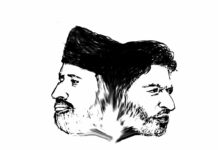Muhammad Tahir
In the late spring of 2010 there was this CRFP gypsy that would make frequent rounds around our locality. A couple of troops would hang menacingly out of it with one hand on a steel handle bar and another holding a long bamboo stick, that they would wave in air every now and then as if to discipline the pedestrians and drivers. While walking on the road I too felt scarred when I saw these troopers waving their thick long sticks and staring coldly at us. They had a big tilak (vermillion line) drawn on their foreheads and they kept spewing expletives at passerby’s.
One day I was walking quietly on the road. Mosques around our locality were abuzz with Kashmiri religious hymns. I was listening to this lilting spiritual orchestra ringing in the air. Suddenly the same CRPF gypsy came from the behind. Inside this gypsy a stereo was blaring out in high volume a Hindu religious song. It seemed as if they wanted to drown the hymns being sung on loudspeakers in the local mosques. It could not have been a coincidence. What could have been possibly the purpose to play loud Hindu religious music at the same time when Islamic hymns were being sung in the mosques? Are so called professional and “secular” armed forces of India under law allowed to act in such a way? Their aggressiveness and cold stares clearly showed the resentment and hatred they harbored for every passing Kashmiri.
The communal nature of the Indian armed forces manifest itself in many ways. The triumphant cry of these forces – Jai Shri Ram or Har Har Mahadev – during any successful military operation is religiously motivated. Even the Indian army and CRPF camps hoist Hindu symbolic images like Om drawn on a saffron flag.
Armoury of the Indian armed forces has names purely drawn from Hindu mythology. Its main battle tanks Arjun and Bhishma are named after Hindu mythological characters in Mahabharta. India’s domestically manufactured helicopter in service of Indian air force – Rudra – derives its name after Hindu mythological god of tempest. Much talked about aircraft carrier purchased from Russia has been rechristened as INS Vikramadatiya named after Hindu King of 1st century BC.
Most of the secular countries name their armory after war veterans or their designers, like General John Pershing, General George Patton, Admiral Gorbashov or have technical names like T-55, T-62 etc. Even theocratic state like Saudi Arabia has retained the original nomenclatures like T-90 or M60A3 for its battle tanks.
Does naming the defence armory after Hindu mythological figures tell us something about Indian state? Yes it does. Because the public symbols and imagery of a state reflects its nature. And when India emphasis and uses cultural resources drawn from Hindu mythology it manifests India as a Hindu majoritarian democracy that clearly chooses from Hindu core cultural resources its public symbols.
In a recent article published in Kashmir Reader (21.07.2013) Seema Kazi charts the history and dubious role of India’s Border Security Forces in post-colonial India. She also examines BSF’s communal nature and how its recruits who mostly “belong to the Hindi-speaking regions of Delhi, Haryana and Rajasthan…known to be deeply conservative (read pro-establishment), reactionary, and communal in outlook and behaviour” are being continually deployed “in states and regions peopled by non Hindi-speaking, non-Hindu ethnic minorities.”
In Kashmir BSF’s notoriety is well-known. Its human rights record during 1990’s rivals even that of Stasi of East Germany (one only need to recall gruesome massacres it carried out in Sopore, Bijbehra, Gool and torture centers it operated in almost all districts of Kashmir). Many Kashmiris feel Indian security establishment’s brutal response to armed and non-armed uprisings in Kashmir was communally tinged because they showed no respect for Muslim religious places and often use communally charged language against Kashmiris.
















and our mountains (though the mountains have rubbed off but leaving a dirty look) have been engraved with ” Ajheet hain——-Abheet hain…………………………….
the Pantha Chowk side gate of Badami bagh Catonment (where the Pakistani Tank lies, the aim is only to ‘make Kashmiries believe that they can’t win over Indian army’!) has been renamed in hindi, again…….